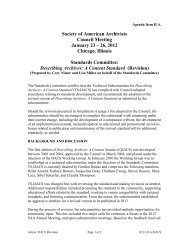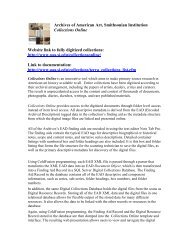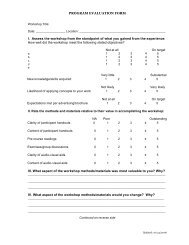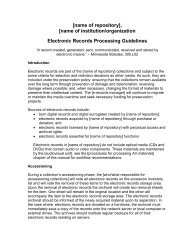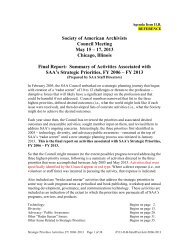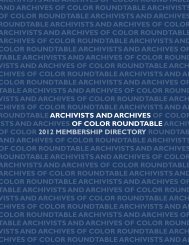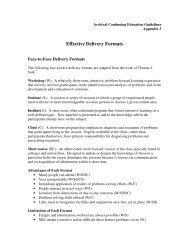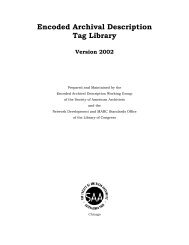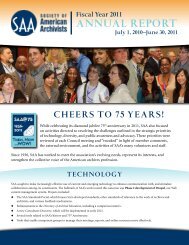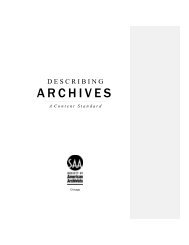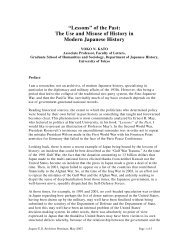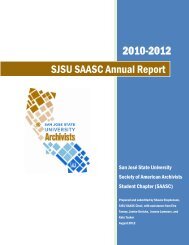Society of American Archivists - US Copyright Office
Society of American Archivists - US Copyright Office
Society of American Archivists - US Copyright Office
Create successful ePaper yourself
Turn your PDF publications into a flip-book with our unique Google optimized e-Paper software.
1. Is the creator still alive?<strong>Copyright</strong>s do not end with death; for most unpublished items, they extend for another 70years after death. If the copyrights had not previously been transferred to a third party (see thenext section), then they would pass to heirs under the terms <strong>of</strong> the will or, in the absence <strong>of</strong> awill, according to the intestate laws <strong>of</strong> the state in which the creator died.If there is more than one heir, it is likely that they will jointly own the copyright in thecreator’s work. For example, if an author has four children and the remainder <strong>of</strong> her estate(including her copyrights) is left equally for them to share, then each child owns a one-fourthinterest in the copyright. If they should pass away, then their estates would divide eachquarter share among the surviving heirs. By the time 70 years have passed and the copyrightenters the public domain, there could be literally dozens <strong>of</strong> copyright owners.Fortunately in an orphan works investigation, the search must identify and locate only one <strong>of</strong>the joint owners <strong>of</strong> an inherited copyright. That joint owner can authorize any use <strong>of</strong> thecopyrighted material, although that individual is obligated to account to the other jointowners for any pr<strong>of</strong>its they may receive from the use.In the case <strong>of</strong> deceased creators, therefore, the search must attempt to identify and locatecopyright heirs rather than copyright creators. Tools to consult in this case include standardgenealogical reference tools, such as obituaries and such online reference tools as FamilySearch (http://www.familysearch.com/), Ancestry.com (http://www.ancestry.com/), andGoogle (http://www.google.com/) for information on the death <strong>of</strong> the author and possibleheirs.2. Did the creator transfer copyright?Any rights owner (both creators and copyright heirs) can transfer their copyrights to a thirdparty. For example, academic authors frequently assign copyright in their articles, andsometimes in their books, to publishers. Literary figures sometimes transfer their copyrightsto executors or to institutions that they wish to support. Mark Twain’s copyrights are ownedby the Mark Twain Foundation, for example, and Marjorie Rawlings, author <strong>of</strong> The Yearling,gave her copyrights to the University <strong>of</strong> Florida. Photographers may assign the copyright intheir photographs to a publication in which it appears or they may retain copyright andmerely license limited use <strong>of</strong> the photographs.Unfortunately there is no requirement that copyright transfers be registered with the<strong>Copyright</strong> <strong>Office</strong> (although they can be). The only requirement is that such copyrighttransfers must be in writing. Thus it is very difficult to know with certainty whether thecopyrights in any particular document have been transferred.Best practice would dictate that potential users <strong>of</strong> copyrighted works follow the contextualclues described in the preceding section. In the absence <strong>of</strong> any readily accessible evidencethat copyright may have been transferred to a third party, assume that the copyright stillbelongs to the creator and search for that creator (or heirs). If there is evidence that the itemmay have been published or copyright otherwise transferred to a third party (for example,editorial and/or layout marks on a document or photograph), search for the publisher as well,for it may have acquired the copyright.<strong>Society</strong> <strong>of</strong> <strong>American</strong> <strong>Archivists</strong> Orphan Works: Statement <strong>of</strong> Best Practices Page 6 <strong>of</strong> 16Rev. June 17, 2009



